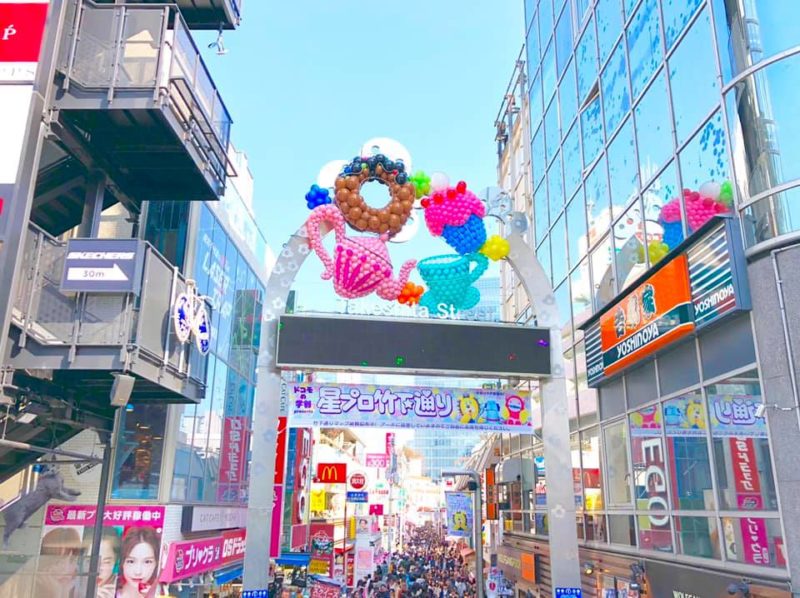- The most popular shrine in Japan
- Love and marriage are fulfilled
- Power spot in central Tokyo
- The highlights of Meiji Jingu
- Access
The most popular shrine in Japan
Meiji Jingu Shrine, located in Harajuku, in the middle of Tokyo, is a popular spot that many people visit as a well-accessed and easily accessible shrine.
The number of worshipers in New Year is the highest in the country every year, and in recent years many tourists from foreign countries have visited.

New Year’s worshipers
In 2012, the Michelin Company in France selected it as one of the “Top 20 3 Star Destinations in Japan” and is known as a representative tourist destination in Japan.
Love and marriage are fulfilled
It is said that the Emperor Meiji and Princess Akinori, who were enshrined in Meiji Jingu, were a compatible married couple.
Therefore, Meiji Jingu is known to have benefits such as love fulfillment and good relationships.
It is also said that there are other benefits such as passing wishes and business prosperity to help you live a good life.
As such, it is said that it has a wide range of benefits, and many worshipers, both young and old, visit the Meiji Jingu daily.
Power spot in central Tokyo
Meiji Jingu is a shrine built in 1920 and enshrining the Emperor Meiji and Princess Akinori.
When Princess Akinori died in 1917, a voice of hope arose from the people to pray for spirits. Only three years later, in 1920, Meiji Jingu was built.
Located near shopping streets where you can enjoy new culture and fashion such as Harajuku, Omotesando and Shibuya, Meiji Jingu Shrine is built in nature.

Takeshita-street, Harajuku near Meiji Jingu
The place is made up of about 100,000 planted forests, and it is an atmosphere that will make you forget that you are in the city center if you step into the site.

The highlights of Meiji Jingu
Kiyomasa no Ido (The well of Kiyomasa)

‘Kiyomasa no Ido’ is a rare spring water well in urban areas. 60 liters of water comes out every minute.
It is said that Kiyoshimasa Kato, a warlord from the Azuchi Momoyama period to the early Edo period, dug himself.
It is located in the Meiji Jingu Gyoen (imperial garden). You can enjoy seasonal flowers at Gyoen, especially from late May, when the flower buds are very beautiful and popular.
※To enter the Gyoen you need an entrance fee of 500 yen.
Kameishi (Turtle Stone)

Image source : https://lineblog.me/regulus4964/archives/514909.html
This stone is located in the northern part of the site and around the northern pond, and is called ‘Turtle Stone’, because it is shaped like a turtle.
It is said that “you can be happy if you touch it” so many people touch it and take pictures.
Meoto-Kusu (Couple camphor tree)

On the left side of the main Shrine there is a large camphor tree sacred tree. Its presence involuntarily stops the viewer’s foot.
At first glance, it looks like a single tree, but if you look closely, the two trees are connected to each other by a rope. It was named “Meoto-kusu (it means ‘Married couple camphor tree’)” from the appearance that each stand as cuddling.
The Meiji Emperor and his wife were very close couples, so Meoto-kusu is considered to be a symbol of family safety and marriage.
It was planted in 1920, and its vitality was very strong, although once it was on fire, the trees have survived.
Wine barrels

The Emperor Meiji is known to be very wine-lovers, so wines are offered as a tribute to the Emperor Meiji from stores in Japan and Chateaus in the Burgundy region of France. As a sight that can only be seen here, it is one of the sights that attracts attention from tourists.
You can enjoy beautiful autumn leaves in the fall

The lined trees road
Meiji Jingu is roughly divided into three areas. There are the main spots “Inner garden”, “National Stadium” and “Bund” located in the direction of Shinanomachi, and “Meiji Memorial”.
The Bund is fully equipped with various sports facilities and is full of people who enjoy golf, baseball, tennis, futsal and ice skating. Also, on the promenade children often see people practicing bikes and jogging.
The most famous place in the Bund is the lined trees road. When you enter Aoyama Dori, beautiful blue young leaves stain in spring and summer, and yellow in autumn, and many people wcome to visit. It is a spot where you can enjoy the superb view of the blue sky and yellow. There are also cafes in the vicinity, so you can spend time while enjoying a meal slowly.
Sometimes you can see a Japanese traditional wedding in front of the shrine and memorial hall
At the Meiji Jingu and the Meiji Memorial Hall just outside the outskirts, you can see traditional Japanese-style weddings.
Brides and grooms walk with their families and relatives in the temple grounds of Jingu.
In the Meiji Memorial Hall, the ceremony be held in a magnificent atmosphere with a profound feeling of doors and cobblestones.
Both are traditional Japanese weddings.
How to enter Meiji Jingu
From Harajuku Exit to Minami-Sando

Access to inner garden is very good, and you can see the torii in a 1-minute walk from Chiyoda Line Meiji-Jingu Harajuku Station and JR Harajuku Station. If you get in from there, you will go through the south approach but there are also many attractive spots such as sake barrels, wine barrels, and large torii, so this course is recommended for beginners.
From Sannomiya Bridge to Nishi-Sando

From Odakyu Line Sangubashi Station, it takes about 3 minutes to get to the Nishi-Sando entrance. If you want to get to the main hall early or you want to see from the treasure hall, this is recommended. You can spend time playing or laying on the grass. There are benches, vending machines and smoking areas.
Access
From JR Yamanote Line “Harajuku Station”
Tokyo Metro Chiyoda Line, Fukutoshin Line “Meiji Jingumae <Harajuku> Station”
1 minute walk from Harajuku exit (south exit)
From JR Yamanote Line “Yoyogi Station”
Toei Subway Oedo Line “Yoyogi Station”
Tokyo Metro Fukutoshin Line “Kitasando Station”
Within 10 minutes on foot from Yoyogiguchi (north exit) exit
From Odakyu Line “Sannomiyabashi Station”
3 minutes on foot from Sangubashi exit (West Exit)


